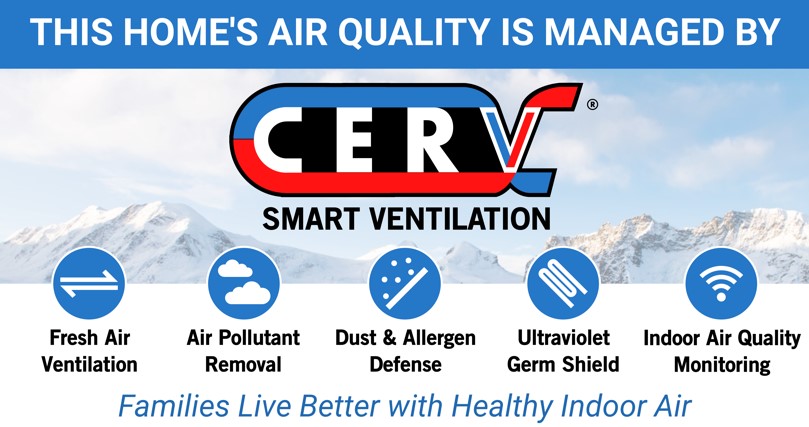
By Victor G. Nino, Ph.D, PE
In our ongoing mission to enhance indoor air quality and promote healthier living environments, we are excited to share the success stories of two recent CERV2 installations in the Metropolitan Milwaukee area. This month, we spotlight the impact of our CERV2 system in both a condominium unit and a single-family home, each with their unique stories and occupants but sharing the common goal of achieving healthy indoor air quality.
Each of these homes serves as a great example of a easy cerv2 retrofit installation in an existing home with high impacts on indoor air quality. Stay tuned, we will have an upcoming article detailing the process of the CERV2 installation in these two homes.
Overview of the Two Milwaukee Residences
Beginning with their similarities, both residences have an area of approximately 2,000 sq. ft. and are inhabited by two occupants. The condo forms one half of a duplex, sharing a wall with its neighbor. Each dwelling is equipped with a central HVAC system, including a furnace and AC, and both homes were built around 2002. A blower door test showed the condo's infiltration rate to be about 3.7 ACH50, while the single-family home's rate is estimated to be around 3 ACH50, based on comparable local data from homes in the neighborhood. These rates suggest a moderate level of air tightness, aligning with 2015 IECC (International Energy Conservation Code), indicating that they were built to surpass the existing standards at the time of their construction.
Neither home features a whole-house ventilation system. Instead, ventilation depends on exhaust fans in bathrooms and kitchens manually operated, along with a makeup air duct integrated into the HVAC system.
Indoor Air Quality Assessments
At Build Equinox, we advocate for the inclusion of indoor air quality (IAQ) assessments with building energy evaluations. IAQ assessments integrate a human-centric element to the building energy audits, ensuring that while we strive for reduced energy consumption, we prioritize creating healthier, more comfortable living environments for everyone.
Our methodology involves the strategic placement of four calibrated air quality monitors within the primary living spaces of a home, including the kitchen/living room, bedrooms, and home office, to capture comprehensive data from the areas most frequented. These monitors are designed to measure a range of critical environmental factors such as indoor temperature and humidity, carbon dioxide (CO2) levels, volatile organic compounds (VOCs), particulate matter (PM2.5), and Radon.
The monitoring equipment is deployed for an extensive period, typically over a week, to ensure a thorough and accurate representation of the home's air quality. The homeowners are also invited to complete a survey that provides valuable insights into their personal health experiences and perceptions of the indoor air quality within their residence.
From Academic Insight to Culinary Delights
At the request of the homeowners, we conducted an Indoor Air Quality (IAQ) assessment in both residences. After sharing the IAQ results and our recommendations with the homeowners, they opted to install the CERV2 system. At this point of the newsletter, the stories will diverge, as there were some distinct IAQ issues encountered in each residence. The narratives will later converge, uniting in the shared experience of enhancing indoor air quality through the installation of the CERV2 system.
IAQ assessment in Robert’s Condominium
The condo is the home to two retirees and a dog. Robert, a former professor from Indiana University, and his wife have settled in Wisconsin to be close to his grandkids. Both human occupants battle with sleep apnea and use CPAP (Continuous Positive Airway Pressure) machines that use air pressure to keep breathing airways open while they sleep. In addition, Peter possesses an exceptionally sensitive respiratory system. He can detect deteriorating outdoor air quality even before his phone app signals an alert, with an Air Quality Index (AQI) of 50 triggering discomfort and values around 70 significantly impacting his well-being. The AQI scale, which ranges from 0 to 500, considers values at or below 100 as satisfactory. However, Peter's sensitivity becomes pronounced at levels as low as 50.
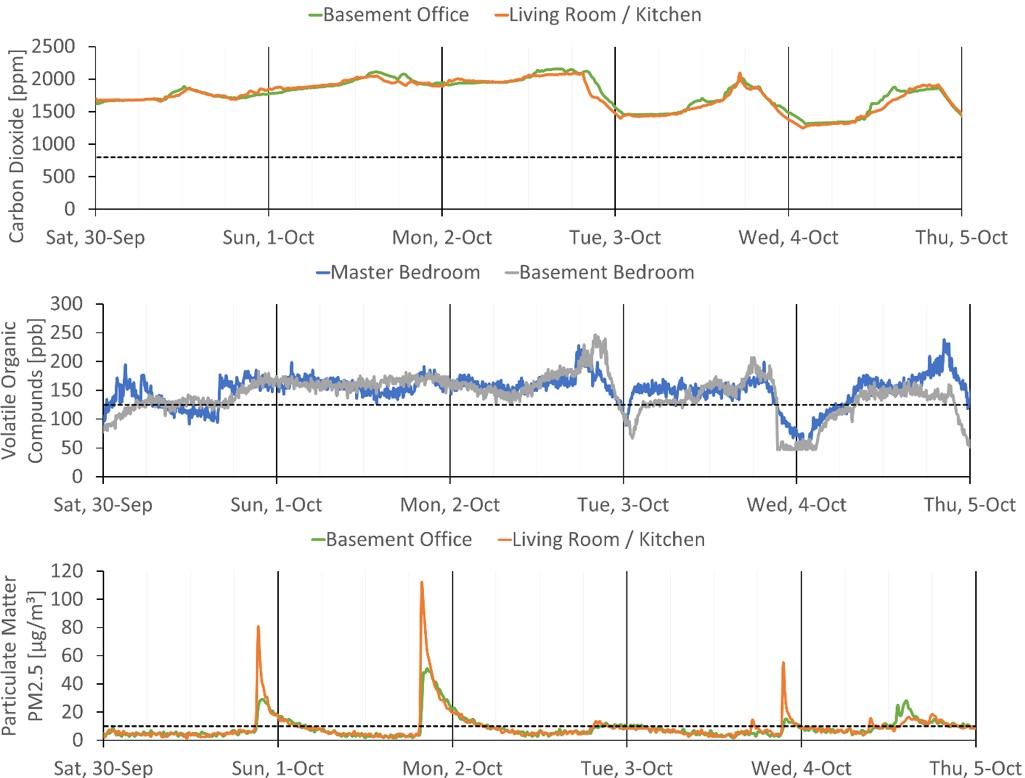
The IAQ assessment at Robert's home revealed key areas of concern impacting the indoor environment. Indoor CO2 and VOC levels consistently exceeded healthy thresholds, indicating inadequate ventilation and a mix of indoor pollution sources. Although particulate matter levels were generally low, spikes in the evenings indicated indoor generation of fine particles. See Build Equinox’ Healthy IAQ Guidelines defining heathy ranges of pollutants.
IAQ assessment in Abuelita's home
The single-family home fondly known as "Abuelita's house", named after Victor's (our Director of Marketing and Business Development) mother, a term of endearment meaning 'grandma' in Spanish. Abuelita Rosalba, a hardworking Colombian grandmother, shares the home with her daughter who works from home. A passionate cook, she often prepares a variety of Latin dishes, from Colombian Arepas for breakfast, to "arroz con pollo" – a dish reminiscent of Spanish paella – accompanied by crispy fried plantains, known as “patacones”, using her gas stove. The intense cooking activity contributes to a sense of stuffiness within the home, underscoring the need for an enhanced IAQ solution.
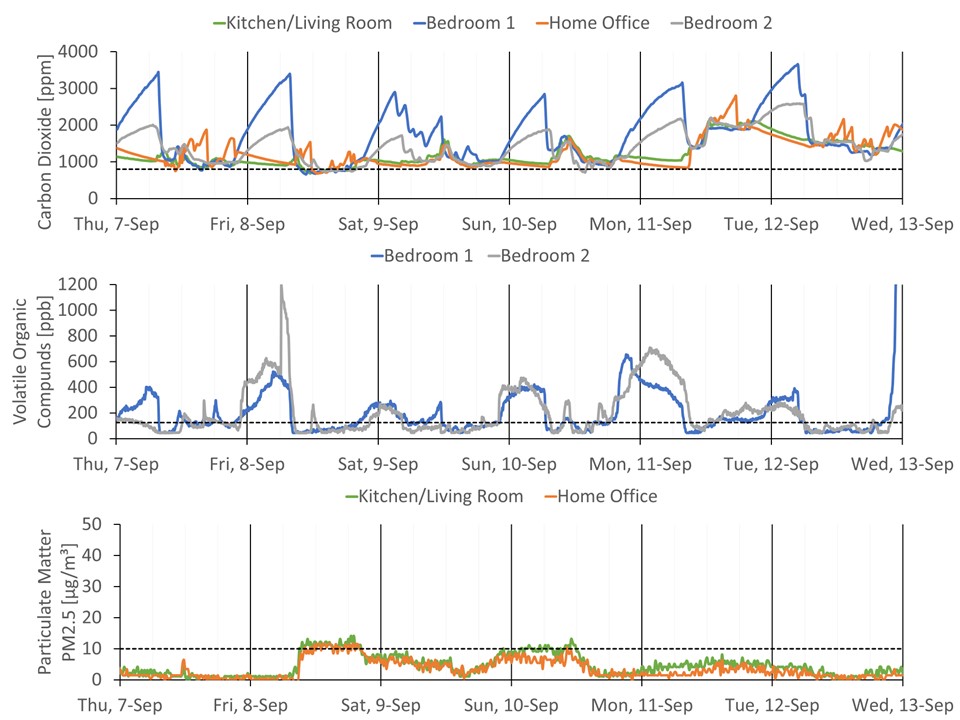
The IAQ assessment at Abuelita's home highlighted critical aspects of the indoor air quality needing immediate attention. CO2 levels were alarmingly high, regularly exceeding healthy limits. In the master bedroom, CO2 levels increased above 3,000 parts per million (ppm) during sleep with the doors closed. Similarly, the second bedroom recorded CO2 concentrations up to 2,000 ppm under the same conditions. Similarly, VOC concentrations frequently surpassed recommended ranges, with peaks exceeding 400 parts per billion (ppb), hinting at various indoor pollution sources, including daily activities. The assessment showed no concerns regarding fine particles (PM2.5).
Integrating CERV2 in Central HVAC Systems
Both CERV2 units were installed by Grant Park Heating & Cooling, an emerging leader in the installation of cold climate heat pumps for residential and small businesses in South East Wisconsin. Nick Hansen, the owner of the company, and his team are advancing their knowledge in creating healthy indoor environments through these projects.
The diagram below illustrates the setup for incorporating the CERV2 into the central furnace/AC system. Two openings were made in the HVAC system's return duct, allowing a portion of the return air to pass through the CERV2. Additionally, two external wall penetrations were created to accommodate the exhaust air outlet and fresh air intake.
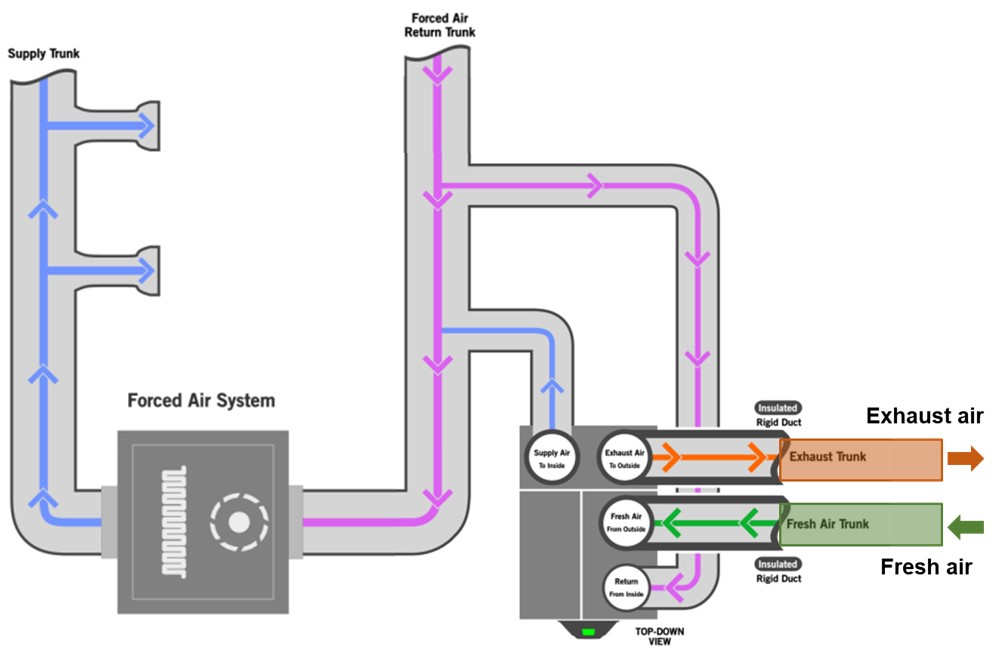
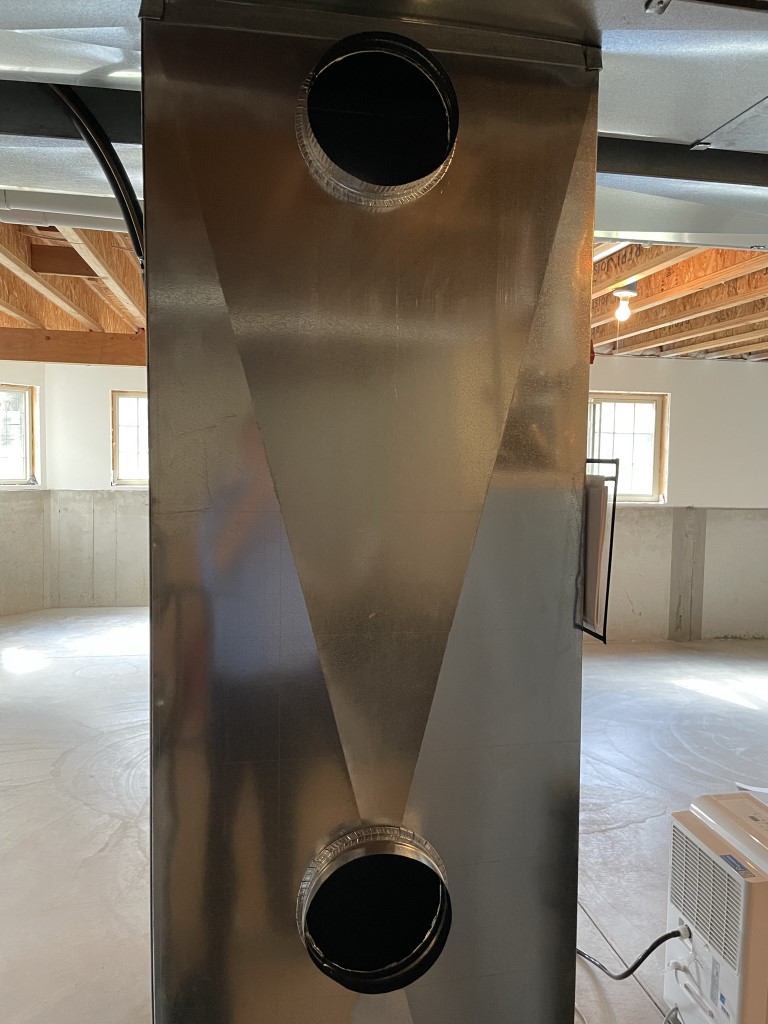
Typically, HVAC installers complete the installation of a CERV2 in less than 6 hours. Their duties encompass drilling through the house wall for the fresh air intake and exhaust, connecting the CERV2 to the central HVAC system using 6” flexible ducts, and attaching the CERV2 to vents installed in the house's wall penetrations, followed by configuring the CERV2 system settings. Depending on availability of electric outlets, the work could include a installing a 110V outlet near the unit's location to power the unit.
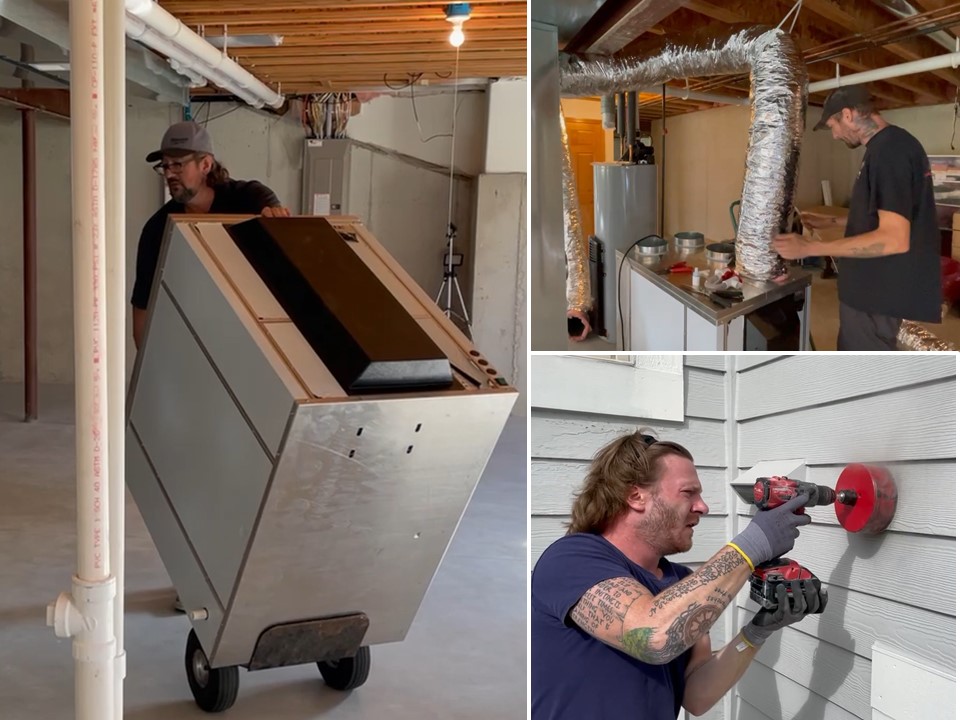
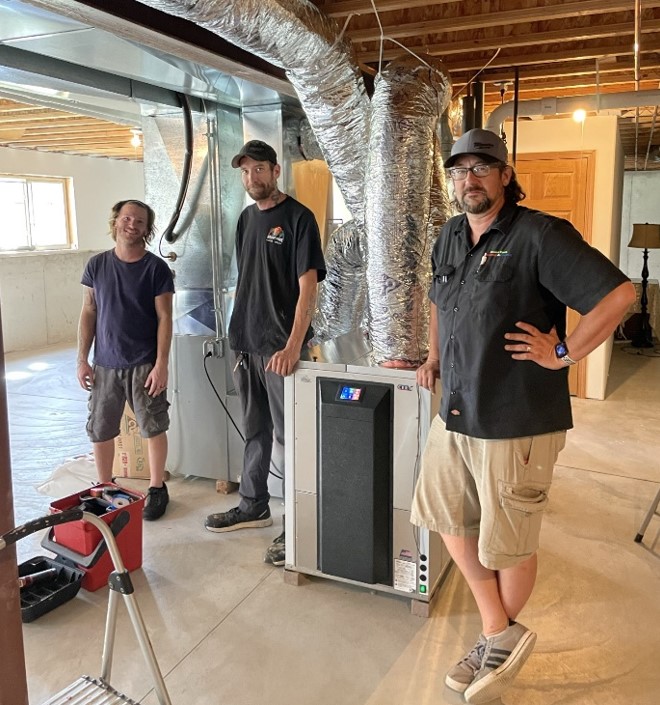
Enhancing Indoor Health: Celebrating Two Indoor Environment Success Stories
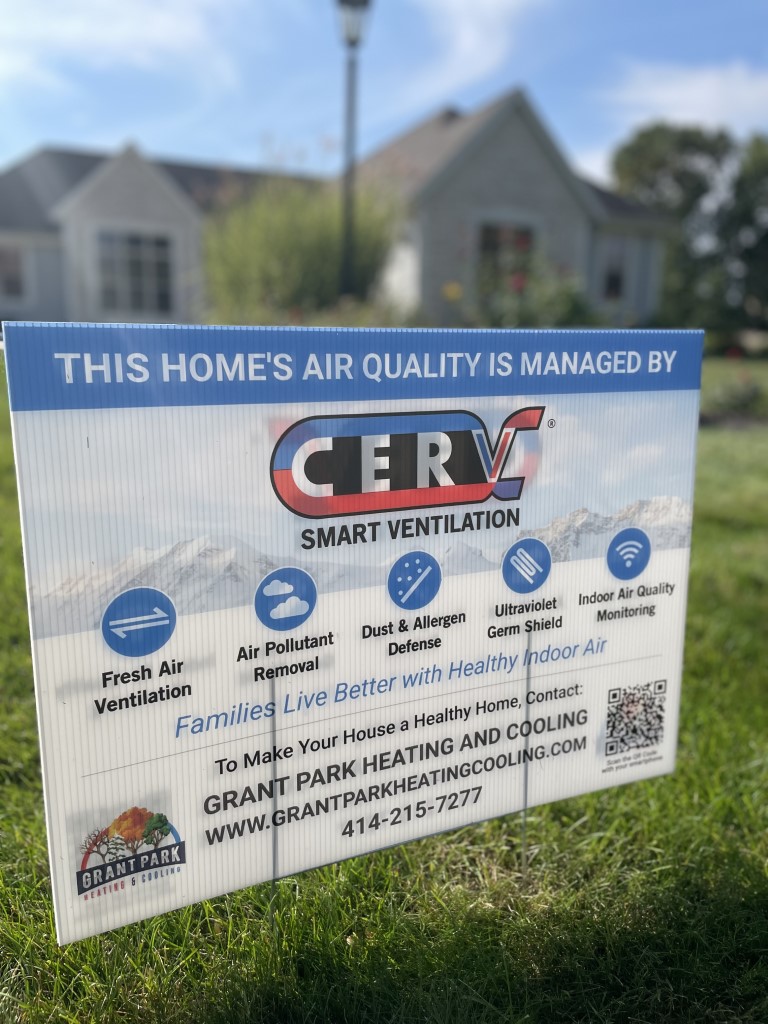
Abuelita Rosalba's IAQ Transformation with the CERV2
The immediate improvement in IAQ following the CERV2 installation at Abuelita Rosalba’s home is evident in the data visualization graphs below, with changes noticeable within just a few hours. The IAQ monitors were installed to record data before the installation, throughout the installation process, and after the installation was complete.
Carbon dioxide levels quickly fell to healthy standards, a significant contrast to the typical nights where they peaked at over 2,000 ppm in the occupant’s bedrooms. This change means that occupants are no longer exposed to high CO2 levels during sleep. Additionally, VOC levels saw a reduction post-installation, with ventilation now more effectively addressing these pollutants, resulting in shorter duration peaks.
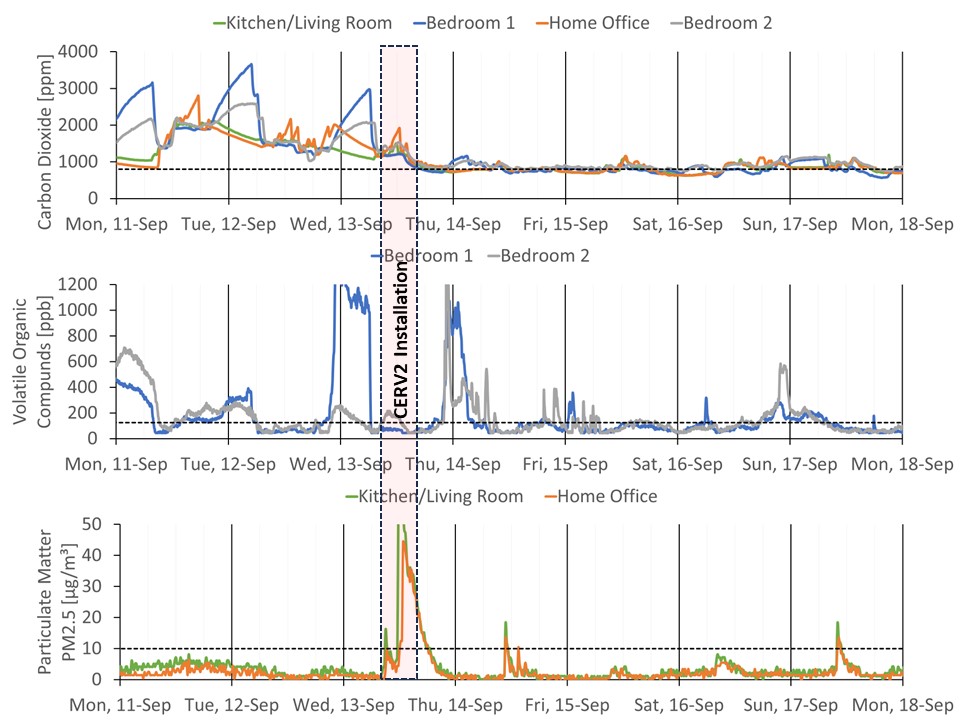
An interesting observation during the installation was a temporary increase in fine particle levels, caused by drilling into the home's walls for fresh air intake and polluted air exhaust. This situation provided valuable lessons about the importance of protective masks for workers and occupants, as well as the benefits of running the central HVAC in recirculation mode and using portable air cleaners to mitigate fine particle concentrations during any home renovations.
Revitalizing Robert’s Home Air Quality with the CERV2
Robert’s home experienced a very similar situation. The immediate improvement in IAQ following the CERV2 installation at Abuelita Rosalba’s home is evident in the data visualization graphs below.
The impact of the CERV2 system installation on indoor carbon dioxide levels was profound (see graphs below). Before the system was installed, CO2 concentrations fluctuated between 1500 and 2000 parts per million (ppm), signifying less than optimal air quality. Following the installation, there was a dramatic improvement, with CO2 levels consistently maintained below 800 ppm.
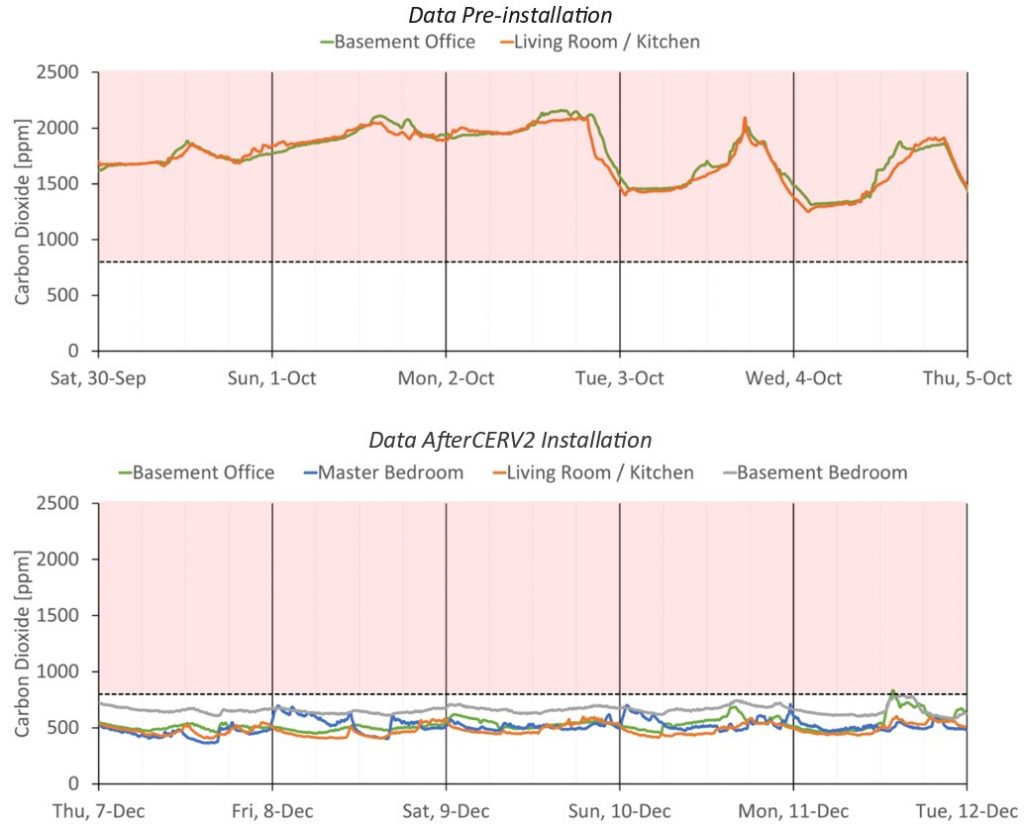
The CERV2's ventilation rates had a markedly positive effect on reducing carbon dioxide levels. During the data analysis, VOC concentrations were also reduced reaching healthy ranges and fostering a healthier indoor atmosphere. Additionally, reductions in fine particle counts were noted, attributable to the CERV2's incorporation of high-efficiency MERV13 filters.
Transformative Results: Robert’s Testament to Cleaner Air
Robert Lehnen’s journey to improve his home’s air quality was not just an upgrade; it was a necessity. Facing health challenges exacerbated by air pollution, including severe headaches diagnosed by his primary doctor as being linked to air quality, Robert needed a solution.
The impact of the CERV2 installation on Robert’s and his wife’s health has been profound. Both use CPAP machines for sleep apnea, a condition that can be negatively affected by poor air quality. Post-installation, Robert reports, “I can tell you; I sleep quite well.” This statement is echoed by his wife, who has also experienced noticeably better sleep.
What stands out in Robert’s story is his heightened sensitivity to air pollution. Previously, Robert could sense outdoor pollution levels rising above an AQI of 50 even before alerts were issued. However, since the CERV2 installation, he no longer notices these pollution spikes—his indoor environment shields him effectively, proving the system's efficacy in maintaining a consistently healthy air quality, irrespective of external conditions.
In a subsequent edition of this newsletter, we will take a closer look at the CPAP data that will be shared by Robert, specifically examining sleep interruptions per hour. This analysis is prompted by Robert’s report of improved sleep quality following the installation of the CERV2, providing a quantitative measure of the system's impact on restful nights.
Tax Deductions Through Preventive Healthcare
During our discussions, Robert shared a valuable tip for homeowners considering similar IAQ improvements. We all may be familiar with tax credits: If you make qualified energy-efficient improvements to your home you may qualify for a tax credit.
Robert, who has long been diagnosed with sleep apnea and respiratory sensitivities, routinely has his medical expenses and bills accounted for by his accountant. Tax law defines medical care expenses as costs for the diagnosis, cure, mitigation, treatment, or prevention of disease, or payments for treatments affecting any part or function of the body.
The costs associated with upgrading his home that includes an energy assessment, weatherization, the CERV2 system installation, a new water heater, and a Radon mitigation system—were substantial but strategic investments in both energy efficiency and health. Robert took a proactive step by submitting these expenses to his accountant for consideration under energy efficiency and medical tax deductions.
This approach highlights a pathway to make such essential upgrades more financially viable. For homeowners looking to enhance their home's air quality while also being mindful of costs, exploring tax deductions for energy-efficient and health-related home improvements can provide significant financial relief.
The Case for Energy Savings while Achieving Healthy Environments
The CERV2 standard unit is equipped with integrated CO2 and VOCs monitors that continuously assess the return air for pollutants. It activates the fan when pollutant levels exceed the healthy thresholds. The unit's quiet fan doubles the ventilation rate (targeting 40 CFM per person) compared to the minimum odor-based ventilation standards prescribed by ASHRAE 62.2 (roughly 15 to 20 CFM per person). This enhanced ventilation rate, validated by numerous studies and academic research, is known to improve health, cognition, productivity, and sleep quality. It is also evidenced by maintaining CO2 levels at the healthy CO2 threshold of 800 ppm in the IAQ graph shown below.
The IAQ data visualization graphs below show the readings, while the CERV2 is in operation, from both the installed IAQ monitors and those integrated within the CERV2. The lower graph highlights the CERV2's operational periods (indicated by green areas) versus non-operational periods (non-green areas), illustrating its energy-efficient usage—activating the fan only when high pollutant levels are detected.
In the CERV2, homeowners can personalize the CERV2 settings, including CO2 and VOC triggers and ventilation rates, using the free CERV-ICE app, allowing for tailored IAQ management based on individual preferences and needs.
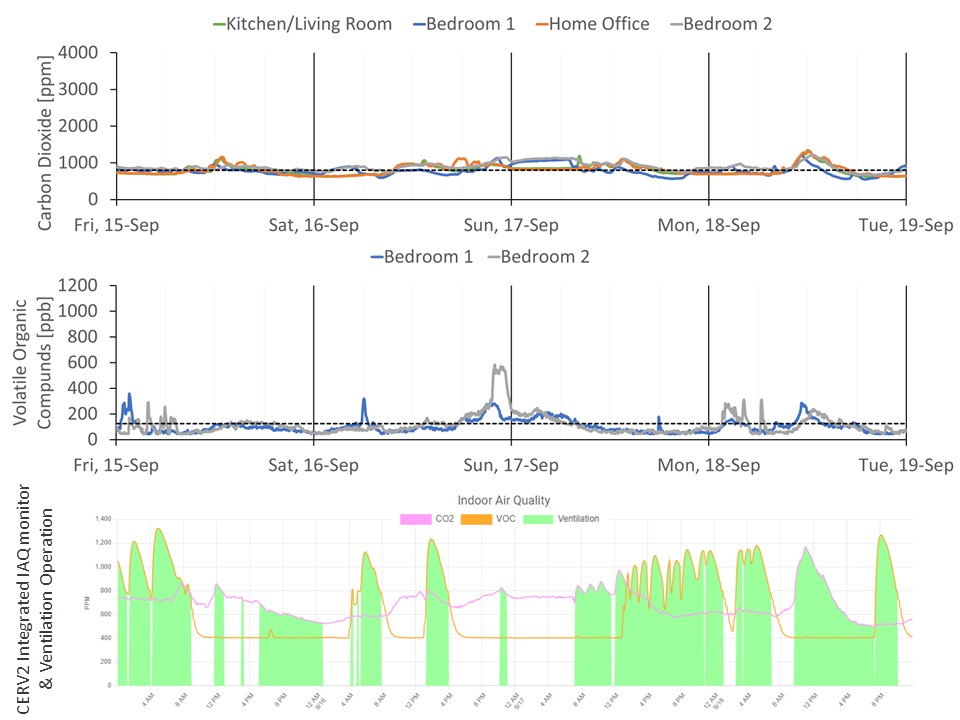
Building a sustainable world that conserves energy and resources for our children's future is crucial, and at the heart of this journey lies the equally vital task of creating healthy indoor environments. Buildings are where people spend their lives, working towards a brighter tomorrow. To truly make a difference, it's essential to go beyond just reducing energy use and carbon emissions. We need to ensure that our buildings promote health and productivity. This is Build Equinox’s commitment to sustainability and health, paving the way for a world that nurtures both the planet and its inhabitants.























